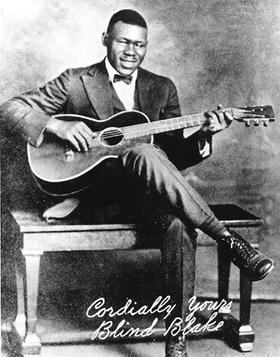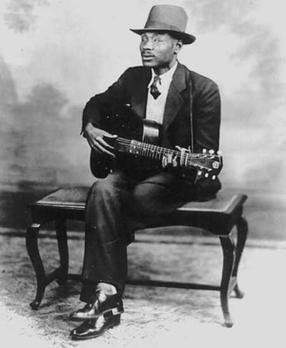
Arthur Blake, known as Blind Blake, was an American blues and ragtime singer and guitarist. He is known for recordings he made for Paramount Records between 1926 and 1932.

Blind Willie McTell was a Piedmont blues and ragtime singer and guitarist. He played with a fluid, syncopated fingerstyle guitar technique, common among many exponents of Piedmont blues. Unlike his contemporaries, he came to use twelve-string guitars exclusively. McTell was also an adept slide guitarist, unusual among ragtime bluesmen. His vocal style, a smooth and often laid-back tenor, differed greatly from many of the harsher voices of Delta bluesmen such as Charley Patton. McTell performed in various musical styles, including blues, ragtime, religious music and hokum.

Ragtime, also spelled rag-time or rag time, is a musical style that had its peak from the 1890s to 1910s. Its cardinal trait is its syncopated or "ragged" rhythm. Ragtime was popularized during the early 20th century by composers such as Scott Joplin, James Scott and Joseph Lamb. Ragtime pieces are typically composed for and performed on piano, though the genre has been adapted for a variety of instruments and styles.

Pinkney "Pink" Anderson was an American blues singer and guitarist.
Lead guitar is a musical part for a guitar in which the guitarist plays melody lines, instrumental fill passages, guitar solos, and occasionally, some riffs and chords within a song structure. The lead is the featured guitar, which usually plays single-note-based lines or double-stops. In rock, heavy metal, blues, jazz, punk, fusion, some pop, and other music styles, lead guitar lines are often supported by a second guitarist who plays rhythm guitar, which consists of accompaniment chords and riffs.

Floyd Council was an American blues guitarist, mandolin player, and singer. He was a practitioner of the Piedmont blues, which was popular in the southeastern United States in the 1920s and 1930s. He was sometimes credited as Dipper Boy Council and promoted as "The Devil's Daddy-in-Law".

Fulton Allen, known as Blind Boy Fuller, was an American blues guitarist and singer. Fuller was one of the most popular of the recorded Piedmont blues artists, along with Blind Blake, Josh White, and Buddy Moss.

Fingerstyle guitar is the technique of playing the guitar or bass guitar by plucking the strings directly with the fingertips, fingernails, or picks attached to fingers, as opposed to flatpicking. The term "fingerstyle" is something of a misnomer, since it is present in several different genres and styles of music—but mostly, because it involves a completely different technique, not just a "style" of playing, especially for the guitarist's picking/plucking hand. The term is often used synonymously with fingerpicking except in classical guitar circles, although fingerpicking can also refer to a specific tradition of folk, blues and country guitar playing in the US. The terms "fingerstyle" and "fingerpicking" are also applied to similar string instruments such as the banjo.

Gary D. Davis, known as Reverend Gary Davis and Blind Gary Davis, was a blues and gospel singer who was also proficient on the banjo, guitar and harmonica. Born in Laurens, South Carolina and blind since infancy, Davis first performed professionally in the Piedmont blues scene of Durham, North Carolina in the 1930s, then converted to Christianity and became a minister. After moving to New York in the 1940s, Davis experienced a career rebirth as part of the American folk music revival that peaked during the 1960s. Davis' most notable recordings include "Samson and Delilah" and "Death Don't Have No Mercy".
Bruce Bastin was an English folklorist and a leading expert on the blues music styles of the southeastern states of America. In 2022, his publication Red River Blues: The Blues Tradition in the Southeast was inducted into the Blues Hall of Fame, as a 'Classic of Blues Literature'.

John Jackson was an American Piedmont blues musician. Music was not his primary activity until his accidental "discovery" by the folklorist Chuck Perdue in the 1960s. Jackson had effectively given up playing in his community in 1949.
Franklin Hovington, also known as Guitar Frank, was an American blues musician. He played the guitar and banjo and sang in the Piedmont blues style. He lived in the vicinity of Frederica, Delaware.
Peter B. Lowry was an American folklorist, writer, record producer, ethnomusicologist, historian, photographer, forensic musicologist, and teacher who dealt with aspects of popular music, mainly African-American.
Charles Henry Tate, known as Baby Tate was an American Piedmont blues guitarist, who in a sporadic career spanning five decades worked with the guitarists Blind Boy Fuller and Pink Anderson and the harmonica player Peg Leg Sam. His playing style was influenced by Blind Blake, Buddy Moss, Blind Boy Fuller, Josh White, Willie Walker, and to some extent Lightnin' Hopkins.

John Dee Holeman was an American Piedmont blues guitarist, singer, and songwriter. His music includes elements of Texas blues, R&B and African-American string-band music. In his younger days he was also known for his proficiency as a buckdancer.
Atlanta blues refers to the local blues scene in Atlanta, Georgia, United States, which had its heyday in the 1920s and 1930s. According to AllMusic,"The Atlanta blues scene of the 1920s was among the most fertile in all the South, with a steady stream of rural musicians converging on the city hoping to gain exposure playing the local club circuit, with any luck rising to perform at Decatur Street's famed 81 Theatre."
James Founty, better known as Dan Pickett, was an American Piedmont blues and country blues singer, guitarist and songwriter. He recorded fourteen tracks for Gotham Records in 1949, several of which have been issued more recently. AllMusic noted that "Pickett had a distinctive rhythmic style and unique phrasing that makes his records compelling decades after his release".
William Augusta Trice was an American blues guitarist, singer and songwriter. He released two singles and an album. He remained loyal to his native North Carolina and its regional blues style, often referred to as Piedmont blues, East Coast blues, or more generally country blues.
Lightnin' Wells is an American Piedmont blues multi-instrumentalist and singer. He is a proficient musician and regularly plays various instruments in concert including the guitar, mandolin, harmonica, ukulele and banjo. At times he has performed as a one-man band. His style encompasses elements of the blues, country, gospel, old-time, bluegrass and folk. Mark Coltrain stated in Living Blues that, "You won't find a more versatile musician around – able to move deftly between country blues, old-time banjo, and novelty tunes with a single pluck. Lightnin' Wells changes the past..."










